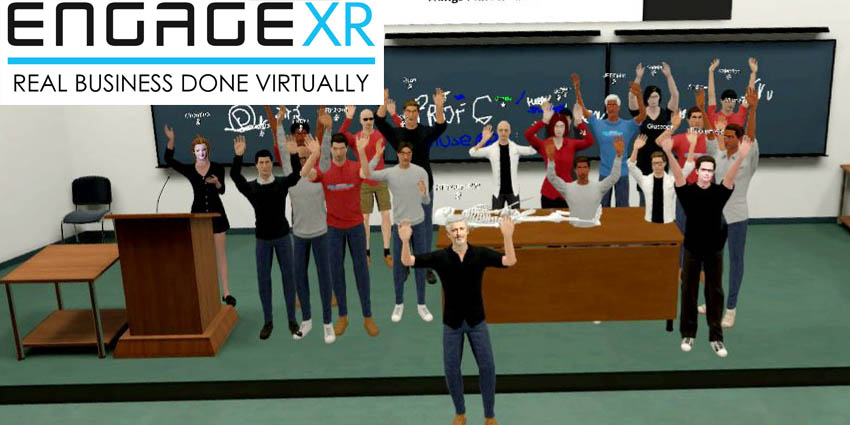There are several virtual reality (VR) immersive education and remote collaboration tools available in the wake of the Covid-19 pandemic, with extended reality (XR) solutions such as Spatial, Horizon Workrooms, Glue, and many others seeking to meet the growing demand.
The Waterford, Ireland-based ENGAGE development team is working tirelessly to provide an up to date remote collaboration solution. The platform offers a vast array of learning and communication tools that suit many enterprise-grade or education use cases.
XR Today sat down with David Whelan, Chief Executive Officer at ENGAGE XR Holdings Plc, to discuss the firm’s recent rebranding, its Metaverse goals, and the future of XR in education.
XR Today: How has 2021 been for ENGAGE?
David Whelan: Until four months ago, the public knew ENGAGE as ‘Immersive VR Education’. We were teasing apps like ‘Apollo 11’, ‘Titanic’ and ‘Shuttle Commander.’ I’m Buzz Aldren and then the Apollo 11 experience.
But, ENGAGE was for educational use cases, so, we built the ‘VR classroom’, where you can go in and teach ‘virtually’ to anybody in the world. Anything you could do in a real classroom, you could also do in our virtual classroom.
Additionally, you can bring in 3D models and do all kinds of stuff. Also, we have a spatial recording feature, which is quite unique and robust.
It will not only record everything you do and say, but it can also record everybody in the session, where you could go in and edit it.
On the PC version of ENGAGE, we have a full editor built into the platform, where you can go in and you can add graphical elements or animations and later, publish that all through the platform.
I think, one of the things that I cringe at—and it’s very, very true—is that I have people come to us, clients from other platforms like Spatial and Glue, who say: “ENGAGE has the best features that nobody’s ever heard of.”
People don’t find us that often actually. They normally find Spatial and Glue first, but are looking around for other platforms. We’re normally the second or third platform they find.
We have major clients like 3M and Fidelity. Facebook, now Meta, is a client of ours as well who uses ENGAGE for corporate events, VIP meetings, and other things. They don’t use their platform, which is very telling.
There are things that we try to do that others don’t. We try to support full-body avatars and make them look realistic, whereas a lot of other platforms go for a cartoon or robot style. VR Chat has a huge range of different avatars that you can have, which is fantastic for a younger audience.
ENGAGE also provides enterprise and education use cases, and that space is for a more professional, older crowd. I think propelled our company along because so many corporations now are trying to onboard employees and make them feel included in a company. That makes a big difference in VR.
Also, we’ve had some events like the HTC VIVE conference, [which took place on] ENGAGE twice and firstly in March when lockdowns first happened in Europe, and over 2,000 people attend.
XR Today: What is new in ENGAGE v2.1?
David Whelan: ENGAGE version 2.1 has improved avatars, so, up until version 2.0, if a user was on the Quest or a mobile device, the only person who was a full-body avatar was the host. Everybody else has a ‘mobile version’ of their Avatar, which is a half-body.
In v2.0, we completely changed the avatar system. Now, you can have 10 Full Body avatars, where the first 10 people in the room are full-body and everybody else is a mobile avatar.
Also, v2.1 has a huge amount of security updates for the platform. We are ISO 2701 certified—the only VR platform to have that security certification, which is a big thing for businesses and enterprise users.
When you have a big client such as 3M or even Facebook (Meta), if you want to work with those companies, they will send you a huge security audit.
It’s going to take between three to six months to get through that. So, in about 200 questions, they’ll ask “Have you got a policy for this? What’s your SNA?”
You have to go through that entire process, but when you have ISO certification, it gets rid of a lot of that red tape and you can do business a lot quicker.
What we’re doing is [creating] a framework for these businesses to build their own ‘Metaworlds.’ So, a client comes to us and goes, “these are the routes that I want and this is the use case. I want it only available on my website.” You can now do that.
Alternatively, ENGAGE is an Amazon Web Services (AWS) cloud service that links clients together in a wider Metaverse of businesses—a place where enterprises are linked together by portals and bridges.
XR Today: ENGAGE generated roughly $1.4m in revenue over the past year. Who are the most important clients to your revenue stream?
David Whelan: That revenue was just the first six months of this year, and we haven’t reported the numbers yet for the remainder of the year, but we’ve had a strong year.
The majority of our clients are US and German-based, places where remote work is becoming a bigger thing. We also have clients in the UAE in the Middle East, but the vast majority of our revenue client base is coming from [the US] and Germany.
Then the split in our client base is 40 percent education clients and 60 percent enterprise clients, although 70 to 80 per cent of the revenue is coming from these enterprise clients.
So, the education clients pay a lower premium, but it’s still a pretty important factor in what we’re doing. You get less per student, but you might get so many more students in the future.
That was the original goal of the platform. It’s more of a focus on enterprise clients for now because that is where the revenue is coming in.
XR Today: Do you feel like XR academia is coming along? How important is it?
David Whelan: With ENGAGE’s toolsets and spatial recording system, if a student misses a class, they can replay that class all over again as if it’s happening live on the platform.
There’s a lot of benefits for XR as an education tool, even just from the communications’ side. We haven’t even touched on simulated learning, where instead of just watching a video of something, a student is actually in the historical experience.
If you’re doing engineering, you can give the students an engineering kit to build a bridge. They can learn all about the dynamics of how to build a structurally sound bridge. There are a huge amount of benefits.
XR Today: Can you introduce the ENGAGE Oasis business Metaverse and the benefits that it will potentially bring?
David Whelan: What we have with ENGAGE Oasis is the ‘central plaza’ that you can explore, and then there’s going to be a bridge to an Enterprise Plaza, an Education Plaza, or Creative Plaza.
For example, when you get to the Enterprise Plaza, there’s going to be a list of doorways for a user to go into a 3M or HTC Metaverse world to meet representatives from those companies and find out about what they’re doing.
That’s the first step in the evolution of networks. The Metaverse is a location for businesses, where each [one] controls their Metaworlds. We are just providing a framework and a way for people to access those worlds if that’s what the businesses want.
To learn more about ENGAGE, kindly visit their website for more information.







